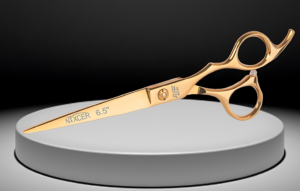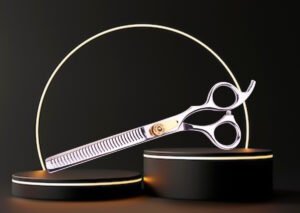Hair cutting scissors play a pivotal role in creating movement within a hairstyle. Movement refers to the flow, texture, and dynamic quality of hair, giving it a lively and natural look. Whether it’s soft waves, layers, or feathered ends, the right scissors and techniques can transform static, lifeless hair into one full of energy and fluidity. Here’s a deeper look at how hair cutting scissors contribute to creating movement.
1. Precision Layering for Natural Flow
One of the key elements in creating movement is layering. Hair cutting scissors allow stylists to precisely cut layers at different lengths, creating depth and dimension. Layers reduce the weight of the hair, allowing it to fall naturally and move with ease. Longer layers, for example, encourage more fluid movement by removing bulk from the bottom of the hair, while shorter layers near the crown add bounce and lift.
When a stylist uses sharp, high-quality scissors, they can cut layers at varying angles, ensuring that the transition between each layer is smooth and seamless. This precision is essential for creating a layered effect that encourages the hair to move freely, rather than appearing stiff or blocky.
2. Texturizing Scissors for Added Movement
Texturizing scissors, also known as thinning shears, are designed to remove bulk and soften blunt edges, making them ideal for adding movement. By selectively cutting some hair strands shorter than others, these scissors create a more natural, textured appearance that allows hair to flow more freely.
For clients with thick, heavy hair, thinning shears can reduce weight and volume, making the hair lighter and more capable of movement. In contrast, for finer hair types, texturizing scissors can create the illusion of fullness and movement without adding unnecessary weight. The result is a look that has dimension, softness, and fluidity.
3. Point Cutting Technique for Soft, Feathered Ends
Point cutting is a technique where the tips of the scissors are used to snip into the ends of the hair at an angle. This method softens the ends of the hair, creating a feathered effect that promotes natural movement. Instead of a blunt, straight cut, point cutting allows the hair to taper off, reducing harsh lines and giving the style a more relaxed, flowing feel.
The versatility of hair cutting scissors, especially when used for point cutting, enables stylists to personalize movement based on the client’s hair texture and length. This technique is particularly effective for creating soft waves, flicked ends, or shaggy, beachy styles that thrive on movement.
4. Slide Cutting for Smooth Flow
Slide cutting is a technique where the stylist slides the scissors down the length of the hair while making small snips. This technique removes weight from the hair without creating harsh lines, allowing the hair to move more freely. Slide cutting is ideal for creating soft, natural-looking layers or blending two sections of hair together to enhance movement.
This technique requires sharp, high-quality scissors that can glide smoothly through the hair without catching or tearing. When executed properly, slide cutting helps create a fluid, flowing look that encourages natural movement, especially in medium to long hairstyles where weight can sometimes cause hair to appear lifeless.
5. Thinning and Removing Bulk for Lightness
Hair cutting scissors, specifically thinning shears, are essential for removing excess bulk from heavy hair. When hair is too dense, it tends to lay flat and lacks movement. By carefully thinning out certain areas, stylists can create a lighter, more dynamic hairstyle that moves effortlessly.
This is especially important for clients with thick or curly hair, where too much bulk can prevent natural movement. Thinning the hair allows the layers to blend more smoothly and reduces weight at the roots, giving the hair room to bounce and flow with ease.
6. Feathering and Razor Cutting for Soft, Textured Movement
Feathering and razor cutting are techniques used to soften the ends of the hair and create texture, both of which are key to enhancing movement. Feathering involves using the tip of the scissors to cut in a way that tapers the ends, creating a more natural, feathery effect. This technique is perfect for layered cuts, as it allows each layer to move independently while still maintaining an overall cohesive shape.
Razor cutting, though typically done with a razor, can also be mimicked with scissors by carefully slicing through the hair at an angle. This technique creates highly textured, wispy ends that enhance movement and give the hair a light, airy quality. Razor cutting or feathering works especially well for styles that require more movement around the face or throughout the layers.
7. Personalizing Movement Based on Hair Type
Not all hair types require the same approach when creating movement, and the versatility of hair cutting scissors allows stylists to customize their techniques to suit each client’s unique needs. For example, straight, fine hair may need more texturizing and layering to encourage movement, while wavy or curly hair might require thinning shears to remove bulk and enhance natural curl patterns.
For clients with straight hair, point cutting or texturizing shears are often used to break up blunt ends and create more fluidity. For wavy or curly hair, scissors help shape and define curls, ensuring they move naturally without becoming weighed down. By tailoring their approach to the client’s hair type, stylists can use scissors to create movement that complements the hair’s natural texture.
8. Maintaining the Integrity of Hair Movement
Achieving movement in a hairstyle isn’t just about cutting; it’s also about maintaining the hair’s health. High-quality hair cutting scissors ensure that the hair is cut cleanly, minimizing damage and split ends. Damaged hair tends to lose its natural bounce and movement, so using scissors that make precise, clean cuts is essential for preserving the hair’s vitality.
Blunt or low-quality scissors can create jagged cuts that damage the hair shaft, leading to frizz and static, both of which detract from natural movement. By using sharp, professional scissors, stylists ensure that the hair remains healthy and capable of flowing naturally with each movement.
Final Thoughts
In essence, professional hair cutting scissors are vital tools for creating movement in hairstyles. Whether through layering, texturizing, point cutting, or thinning, these scissors enable stylists to craft hair that flows naturally and moves with ease. The right cutting techniques combined with high-quality scissors result in hairstyles that are not only visually dynamic but also versatile and easy to maintain. Movement in hair is the key to a fresh, natural look, and the proper use of scissors is fundamental to achieving this effect.



